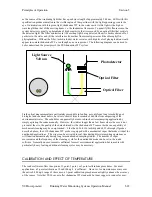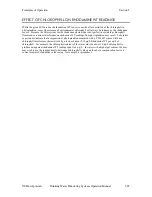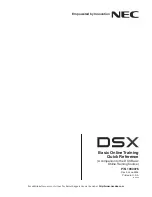
Principles of Operation
Section 5
YSI Incorporated Drinking Water Monitoring Systems Operation Manual
5-10
(4) Nitrate standards are good growth media for a variety of organisms. This growth can significantly
reduce the nitrogen content of your standards, an effect that is particularly important for the 1 mg/L
solution. It is best to use new standards for each deployment, but if you decide to save your solutions for
reuse, we recommend refrigerated storage to minimize the growth of these organisms.
(5) Remember that the nitrate sensor will take longer to stabilize after exposure to pH buffers. To
accelerate this process, soak the sensor in 100 mg/L standard for a few minutes after performing a pH
calibration. In addition, be particularly careful that readings are stable during nitrate calibration after
exposure to buffers.
CAUTION
:
The nitrate membrane module is for use only at depths less than 50 feet (15.2 meters). Use of
the probe at greater depths is likely to permanently damage the sensor
.
5.09
5.09
5.09
5.09
AMMONIUM AND AMMONIA
AMMONIUM AND AMMONIA
AMMONIUM AND AMMONIA
AMMONIUM AND AMMONIA
The sonde ammonium probe employs a silver/silver chloride (Ag/AgCl) wire electrode in a custom filling
solution. Nonactin membrane separates the internal solution from the sample medium and this membrane
selectively interacts with ammonium ions. When the probe is immersed in water, a potential is established
across the membrane that depends on the relative amounts of ammonium in the sample and the internal
filling solution. This potential is read relative to the reference electrode of the sonde pH probe. As for all
ISEs, there is a linear relationship between the logarithm of the ammonium activity (or concentration in
dilute solution) and the observed voltage. The Nernst equation describes this relationship.
Under ideal conditions, the Nernst equation predicts a response of 59 mV for every 10-fold rise in
ammonium activity at 25°C. In practice, however, empirical calibration of the electrode is necessary to
establish an accurate slope of the response. Typical empirical slopes are 53-58 mV per decade for YSI
sensors. This slope value is determined by calibration with two solutions of known ammonium
concentration (typically 1 mg/L and 100 mg/L NH
4
+
-N).
The slope of the plot of log (ammonium) vs. voltage is also a function of temperature. The slope changes
by a factor that is the ratio of the absolute temperature of calibration to absolute temperature of
measurement. The point where this new plot of log (ammonium) vs. voltage intersects the calibration plot
is called the isopotential point, that is, the ammonium concentration at which changes in temperature cause
no change in voltage. Our experience with ISEs indicates that for best accuracy, the isopotential point
should be determined empirically. To do so, use a third calibration point where the voltage of the lower
concentration standard is determined at a temperature at least 10°C different from the first two calibration
points. The slope, offset, and isopotential point drift slowly, and the probe should be recalibrated
periodically.
All ion selective electrodes are subject to interference from ions, which are similar in nature to the analyte.
For example, sodium and potassium ions bind to the ammonium membrane and produce positive readings
even when no ammonium is present. Fortunately, fresh water does not usually contain enough interfering
ions to produce large errors. For example, a common conductivity for freshwater is about 1.2 mS/cm (Sal
= 0.6). Even if the ionic content were due to sodium chloride, the ammonium reading would be
erroneously high, about 0.4 mg/L.
However, brackish or seawater has enough sodium and potassium to cause interference so great as to
make the sensor unsuitable for these media.
The sensor used in the sonde detects only ammonium ions (NH
4
+
), the predominant form of total
ammonium nitrogen in most environmental samples. However, using the concurrently determined values
of pH, temperature, and conductivity, the sonde software can also provide the user with the concentration
of free ammonia (NH
3
) in the sample under investigation.
Содержание 600DW-B
Страница 3: ......
Страница 239: ...Principles of Operation Section 5 YSI Incorporated Drinking Water Monitoring Systems Operation Manual 5 26...
Страница 251: ...Warranty and Service Information Section 8 YSI Incorporated Drinking Water Monitoring Systems Operations Manual 8 4...
Страница 259: ...Required Notice Appendix B YSI Incorporated Drinking Water Monitoring Systems Operations Manual B 2...
Страница 264: ...EMC Performance Appendix D YSI Incorporated Drinking Water Monitoring Systems Operations Manual D 2...
Страница 268: ...Specifications Appendix E YSI Incorporated Drinking Water Monitoring Systems Operations Manual E 4...
Страница 297: ......
















































